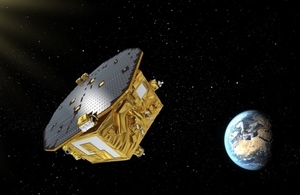LISA Pathfinder exceeds expectations
ESA’s LISA Pathfinder mission has successfully demonstrated the technology needed to build a space-based gravitational wave observatory.

Artist's impression of LISA Pathfinder. Credit: ESA.
Results based on two months of science operations show that the two test masses at the heart of the spacecraft are falling freely through space under the influence of gravity alone, with no disturbance of other external forces, to a precision more than five times better than originally required.
The successful demonstration of the mission’s key technologies opens the door to the development of a large space observatory, capable of detecting gravitational waves emanating from a wide range of objects in the Universe.
LISA Pathfinder was launched in December 2015 by ESA for a 9 month mission to test the key technologies which would be needed to detect gravitational waves (tiny ‘ripples’ in space-time caused by massive astronomical events such as merging black holes and supernovae explosions) in space. It is the first step towards being able to use gravitational waves as an entirely new way of observing the Universe, and it uses some of the most precise and advanced technology ever launched.
The mission involves putting 2 small metal blocks into the purest free-fall ever achieved as they float inside an enclosure in the spacecraft, and then demonstrating that the effects of all forces apart from gravity (including temperature effects, magnetic field, noise generated by the spacecraft) which could disturb the cubes and cause relative movements, can be excluded. The mission also needed to demonstrate that the relative movements of the cubes could be tracked with lasers to an accuracy of just 10 picometres (a picometre is less than the width of a Hydrogen atom). This required an unprecedented understanding of the physical forces involved and the technological advances needed.
The innovative spacecraft was built by Airbus Defence & Space UK, with on-board software development by SciSys Ltd. It is the first ESA science spacecraft led by the UK since Giotto in 1985. Key elements of the exquisitely precise payload - the optical bench, the phasemeter and the charge management system - were developed and built by teams at the universities of Glasgow, Birmingham and Imperial College London, respectively.
The UK’s involvement in LISA Pathfinder is funded by the UK Space Agency.